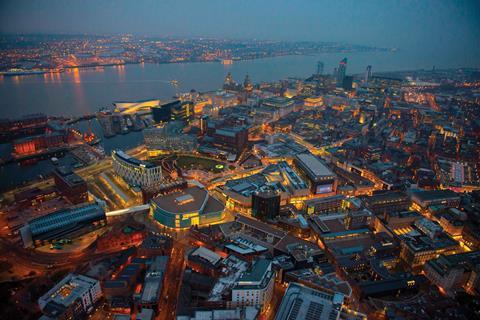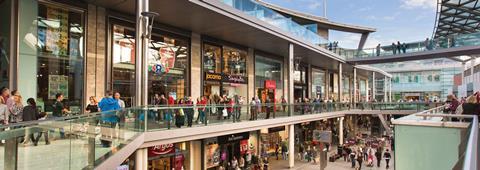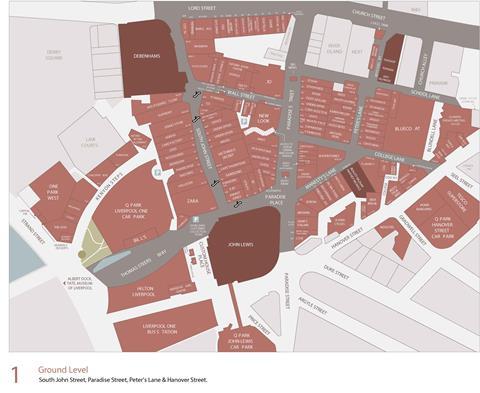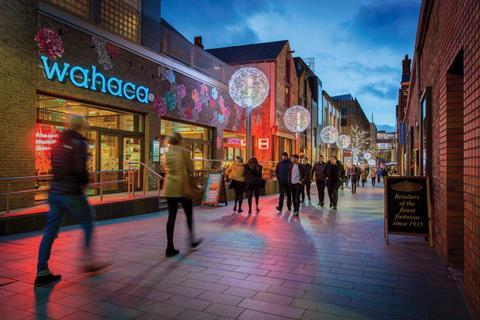With the British high street in the doldrums, Ike Ijeh revisits Liverpool One which, 10 years after it first opened, still manages to buck the trend – attracting 30 million visitors each year. Linking the city and the iconic waterfront has been crucial to its success but what other lessons can it offer?

If the British high street had hoped it could start the new year by putting its 2018 woes behind it, the succession of dire trading figures from last Christmas have proved it was sorely mistaken. British retailers suffered their worst Christmas sales since the depths of the recession in 2008 with December 2018 revenues rising by only 1.4% on the previous December, according to figures from the Office for National Statistics.
Sadly this is reflective of wider sluggishness across the British retail sector, compounded or perhaps created by the seemingly unstoppable rise of internet shopping. The UK high street conveniently lends itself as the physical embodiment of this decline, and a lethal combination of disappearing household-name retailers and testing economic conditions has led to some depressing statistics.
Latest figures presented to the housing, communities and local government select committee show that in the last 10 years footfall in town centres has dropped by 17%, vacancy rates have risen to over 30% in some locations, and more than 400 multiple retailers have gone out of business. The results are all too clear to see in the succession of boarded-up shopfronts that scar high streets and town centres up and down the land.
Rewind: Liverpool One on-site - welcome to paradise (2008)
In pictures: Grosvenor opens £1bn Liverpool One today (2008)
Mini cost model: The evolution of retail (January 2019)

Showing how it’s done
But what if one city centre has managed to buck this trend? What would it mean for the rest of Britain’s struggling high streets if – outside central London – one of their number had actually managed to crack what, except for housing, is perhaps the single defining urban and socio-economic conundrum facing British cities today: namely, creating successful physical retail in the internet age and using this formula to revive Britain’s embattled high streets?
Liverpool One has been a runaway success. Before the final segment of the showpiece city centre retail-led scheme opened a decade ago this month, the formerly largely derelict 42-acre site where Liverpool One was built would attract around 500,000 visitors a year – today Liverpool One attracts 30 million, according to councillor Gary Millar, deputy mayor of Liverpool for business, economy and skills.
Despite being one of the top 10 largest cities in the UK, when Liverpool One opened Liverpool city centre was the 17th most popular retail destination in the UK – today it is the fifth, says Millar. According to owner Grosvenor, over the past decade Liverpool One has increased footfall by 53% and sales by 110%. This in turn has generated £3.3bn for the local economy, more than half of which has been paid as wages for local residents. For every £100 generated by the Liverpool regional economy, £1.20 is delivered by Liverpool One alone.
On a broader scale, the success of Liverpool One has also had a significant wider economic impact across the entire city of Liverpool. With a 2.4% increase in footfall during 2018, the city saw a third consecutive year of footfall growth last year. In 2008, 30 million people would visit Liverpool city centre every year; today almost 60 million do.
This is in stark contrast to the state of UK city centres as a whole, which suffered a -2.5% slump in retail footfall in 2018 – with a -1.5% drop in the north of England region. And in the 10 years since Liverpool One opened, Liverpool’s visitor economy has enjoyed an average growth of 6.5% per year, rising by a total of 66% from £2.73bn in 2008 to £4.53bn today, according to Liverpool City Region Local Enterprise Partnership.
Of course, not all of this can be attributed to Liverpool One alone. Liverpool’s extraordinary renaissance over the past decade or so has been driven by two other key factors, its selection as European City of Culture in 2008 and the opening of the Liverpool Arena and Convention Centre in 2015. But it is indisputable that Liverpool One has been an integral part of this wider civic rebirth and that in a difficult climate, it is enjoying levels of urban and economic success that other similar retail developments across the country could only dream of.
Also read: Can retail parks be turned into proper mixed-use communities?
Also read: Why we need to factor the millennial into the evolution of the high street

Connections
So how did Liverpool One do it? For deputy mayor Gary Millar, there are several reasons why Liverpool One works. “It respects heritage but embraces modernity; it offers different types of architecture; it provides high-quality public spaces and it’s highly innovative in both retail and design terms.”
But Millar claims there is one overriding characteristic that has been central to Liverpool One’s success: its connectivity with the rest of the city. “It’s not like a normal shopping centre, it’s completely embedded into the surrounding streets and crucially, it finally provided a connection between the city centre and the waterfront. It seems incredible now but that had never existed before.”
Liverpool One was built on a network of largely derelict and underused streets and car parks surrounding a bleak, arid expanse of patchy open space known, optimistically, as Chavasse Park. By the time proposals for redevelopment were first being discussed in the late 1990s, many of the buildings on the site had been left derelict since bombing in the Second World War. In fact, according to Liverpool council at the time, Liverpool One represented “the largest city centre development in Europe since post-war reconstruction”.
But despite this historic oversight, the old district represented something else very important and very damaging: it was both a physical and symbolic barrier between Liverpool city centre and its waterfront, the latter being one of the city’s biggest physical and cultural assets. Much of that waterfront had enjoyed committed redevelopment during the 1980s as part of the Lord Heseltine-spearheaded regeneration of the city, and by the 1990s its showpiece Albert Dock was home to Britain’s second Tate Gallery and a gaggle of celebrity Liverpool FC footballers.
But due to the barrier of Chavasse Park and environs, the waterfront was developed largely in isolation from the rest of the city centre and consequently, none of Albert Dock’s revivalist glamour spilled over into shopping streets just yards away. But by forging a masterplan that ploughed a series of new pedestrian links between city and docks, Liverpool One ended this severance for good and both the development and the city have benefited enormously from it ever since.
Word on the street
So, what do those who actually use the centre have to say about it? We went out and about in Liverpool one to ask a few…

Dave and Maureen are an elderly couple from Birkenhead on the Wirral, across the River Mersey from the city. Dave grew up in Aigburth, an affluent south Liverpool suburb, then worked as a clerk near Pier Head. But he remembers all too well the poverty and dereliction that afflicted the city centre in the 1970s and 1980s: “This part of town was just dead; the river and town were like two different zones that never interacted. There used to be a bus station here called Paradise Street but it was anything but – coming here felt like stumbling across the twilight zone. But now we love it here: we just can’t believe the difference. We come here every week and even if we don’t buy anything, we’ll just get a cup of tea and watch the world go by.”
Sheila is a full-time mother who lives in Runcorn, 17 miles south-west of Liverpool. Manchester used to be her first choice for shopping but she is now a Liverpool fan. “Lewis’ used to be the big posh department store in Liverpool and I remember being really disappointed when it closed and thought the city centre would go downhill from there. But it’s the opposite now; there’s so much choice and I like the fact you have the big chains but smaller interesting shops too. But what I like best is that it doesn’t feel like a shopping centre: you’ve got all the shops in one place but you can see the sky too.”
Shane and Mickey are street performers who haven’t come to Liverpool One to shop but to sing impassioned renditions of current chart hits from their spot on the corner of Lord Street and Paradise Street. They like this spot on the northern edge of the shopping centre because, Shane explains: “It’s always busy here, always full of people; when you perform here loads of people stop and listen and it sometimes feels as if you’re on stage at a concert. Personally I’m not really into shops and all that but when you get a good crowd here you just can’t beat the buzz: it’s electric.”

Masterplan
The masterplan in question was designed by BDP and to date it remains the only masterplan that has ever been nominated for a RIBA Stirling prize. For BDP director Mark Braund, the link between city and waterfront is crucial to Liverpool One’s success. He says: “It completely transforms the way in which people move around the city. It does this by understanding pedestrian connections and desire lines and creating new routes that match them. Any loss of ground floor trading area this requires is more than justified by the creation of a network of high-quality public spaces that embed the scheme into the city fabric.”
As Braund implies, the new public spaces in themselves are only half the challenge: how they are connected to the rest of the city is another crucial ingredient of Liverpool One’s success. Liverpool One is an entirely open-air shopping district, the largest of its kind in the UK. Crucially the connections between its streets and those that surround it are seamless and the development almost bleeds invisibly into the streetscape and fabric of the city. This is most sensitively executed around Bluecoat Chambers, an elegant Queen Anne courtyard block on the edge of the Liverpool One site which the development surrounds with an intimate network of similarly scaled shops, courtyards and lanes filled with independent cafes and boutiques. These mark a significant shift in scale and in tenant type and size, away from the bigger retail blocks in the remainder of the development populated by familiar high-street brands.
For Braund, this sensitivity of approach is critical in making Liverpool One feel like a part of the city. “It’s not a traditional shopping centre that treats shopping as something that needs to happen under a single roof and behind closed doors; it’s a seamless and fully integrated shopping experience for a new part of the city. The traditional red-line boundary doesn’t matter, it’s the placemaking and connections that are important.”
Mix
Something else that’s important to Liverpool One’s success is diversity, both in terms of design and use. Liverpool One contains around a dozen separate buildings divided into six distinct city “neighbourhoods”. It was also designed by around 20 different architecture practices. Therefore, the development bears no uniformity of style and architecturally is not identified as a single homogenous entity within the city fabric. Both these elements enable it to more easily insert itself into the significantly smaller-scaled grain and proportions of the surrounding streetscape.
Equally, while it is an undoubtedly retail-led development of 170 shops, Liverpool One is also a committed mixed-use scheme containing a hotel, cinema, restaurants, leisure amenities, the reconstituted and now rooftop Chavasse Park built over a new underground car park and, most surprisingly to some, around 600 residential units.
Something else that Liverpool One contains is a new bus station which now includes Liverpool’s main coach station. As Millar explains, its connectivity with local, regional and national transport infrastructure as well as its physical integration into surrounding fabric has also been key to its success. “If you get a coach from London to Liverpool, it drops you off at Liverpool One. This means that the development is fully integrated into national transport routes, especially with the underground Merseyrail train stations being nearby.
“As well as these public transport options, there are 3,000 car parking spaces, two-thirds of which are underground and not clogging up prime surface retail or public space.”
Braund also speculates that the design of Liverpool One has enabled it to adapt more nimbly to the changes in the retail environment that have occurred over the past decade, including the internet. “Ten years ago in shopping centres there was much more a sense of retailers competing with each other. That’s different now, there’s much more of a community of retailers where they work together to provide more of a communal, curated shopping experience, almost like a museum.
“Liverpool One was at the forefront of this and its influence is now visible in other new shopping centres like Leeds Trinity, Northgate Chester and Westgate Oxford. What’s important now is creating an experience as part of what differentiates physical shopping from online.”
Braund also strongly maintains that the planning and development process that led to the construction of Liverpool One was key to its success. “For major city transformation on this scale you can’t rely on a traditional planning system. The council were proactive right from the start, awarding special planning powers and providing a dedicated team to work solely on this project. The intensity of collaboration between Grosvenor and the city was also crucial in persuading the developer to do something revolutionary.”

Legacy
Inevitably over the past decade Liverpool One has attracted some criticism. Some have lamented the closure of retail units in the nearby thoroughfares of Lime and Ranelagh streets and before its completion there was great concern in the city that the development would suck revenue and footfall away from traditional city centre shopping areas such as Liverpool’s much-loved destination for independent and alternative retail, Bold Street.
But Millar is adamant that this has not been the case. “Bold Street has capitalised on the fact that it offers a different kind of retail experience and because Liverpool One brings more people into the city, that’s more people available for different kinds of businesses and retailers to attract. Bold Street experienced an 11% year-on increase in sales this Christmas and has a vacancy rate of 2%, 10% below the national average.
“Yes, Lime and Ranelagh Streets have become less retail focused but there’s a new emerging cafe culture there that offers a new kind of leisure experience. It’s not a case of decline but reinvention, reinvention is the key to making city economies thrive and Liverpool One has helped promote that.”
Inevitably, it would difficult to replicate the success of Liverpool One because the circumstances that led to its construction – a cluster of bombed-out wartime buildings on prime sections of underused land right in the heart of the city centre under the ownership of a single landlord – were so unique.
But a decade after its opening there are definite lessons Liverpool One can teach the struggling physical retail sector. Strong connectivity, integrated infrastructure, architectural variety, high-quality public realm, a committed planning vision, a vibrant mix of uses and a curated retail experience have all helped Liverpool One become the remarkable success it is today.
But chief among these is the enthusiasm and seamlessness with which Liverpool One embeds itself into the grain, streetscape and fabric of the city. Perhaps Liverpool One’s lasting lesson for how physical retail is to survive in the 21st century will be that it’s necessary to make shops feel less like shops and more like the city.




























No comments yet